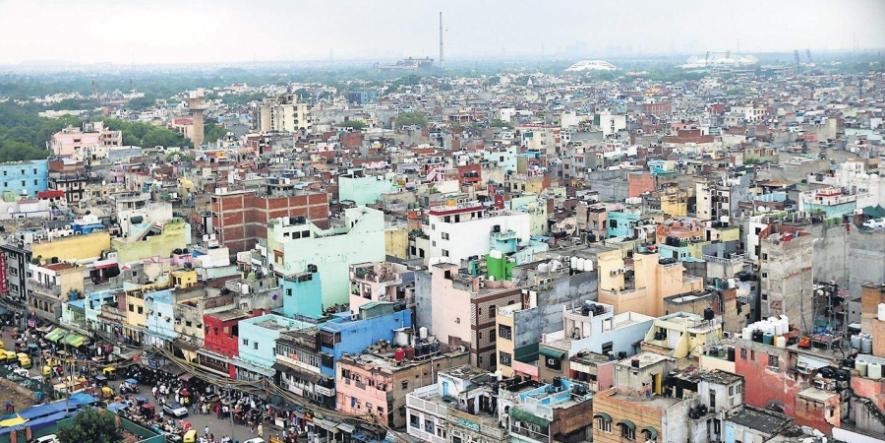Regularisation of Unauthorised Colonies is Good, But What About Slums

Representational image. | Image Courtesy: New Indian Express
Recently, the Arvind Kejriwal government in Delhi welcomed the decision of the Ministry of Housing and Urban Affairs (MoHUA) to regularise 1,797 unauthorised colonies (UAC) in Delhi. There is a wave of cheer in the city amongst residents in these UACs, but there is also deep scepticism. The residents are aware of the history of such decisions taken in the past, some of which were partly implemented, and some taken only during elections and never implemented. The present time period also generates this scepticism, as elections to the Delhi Assembly are a few months away.
Why did the Bharatiya Janata Party-ruled central government keep the file of regularisation of UACs under the carpet for almost three years, as the Aam Aadmi Party government in Delhi has claimed?
Apparently, such UAC colonies exist in a large number of cities in the country. Since urban development is a state subject, there are laws in respective states under the town and country planning department to deal with regularisation of UACs. Here we would like to deal with the Delhi model.
Before we go into the details of the proposals, let us understand what the UAC colonies mean.
UNAUTHORISED COLONIES
Unauthorised colonies, unlike slums, are habitations where land has been bought by the people and then houses were constructed on this land. Or, there may be cases where the landowner herself has constructed houses and sold them to multiple buyers. Slums are mainly on government land; they occupy not more than 3-5% of the total land mass of the city. We are not sure how much land mass in the city is under UACs, but for obvious reasons it is not less than 15%. In 1962, there were 110 unauthorised colonies where some two lakh people lived. As of now, about 50 lakh residents, which are 30% of Delhi’s population, reside in these colonies.
Why is it that despite the fact that land in majority of colonies was bought by the people, yet the houses and habitations are termed unauthorised? One of the reasons is that they do not confirm to the provisions of the ‘master plan’ of the city.
The master plan is a statutory document that exhibits how the town should be shaped. Some of the UACs are constructed on land that was meant for agriculture, a few on river banks etc. Besides, the floor area ratio (some places it is called FSI), used in zoning to limit urban density and to limit the vertical height of the building, was also compromised. In simpler language, this means that in a colony, where only three-storey buildings were to be constructed, more than that number were built by people and hence it is unauthorised.
The characteristic of a UAC is that its residents cannot legally transfer their land, and service provisioning is low and insufficient. Residents do, however, enjoy more secure land tenure rights than those in other types of unplanned settlements, like slums (slum-designated areas) and jhuggi jhonpri clusters (non-notified slums, or JJCs).
The crisis has also precipitated because of the failure of the Delhi Development Authority (DDA) to meet the ever-growing demand of low-cost housing in the capital, which has led to a mushrooming of unauthorised settlements. According to the master plan, 80% of the housing should have been for the economically weaker sections. However, the inverse has happened. The DDA constructed only 20% housing for EWS.
REGULARISATION
The essence of regularisation is to change land usage. Such areas are the ones where people inhabit it, bypassing the norms. However, the government can regularise these colonies owing to people’s pressure and thus turn a UAC into a legal one.
In the past, too, some of the colonies were regularised. In 2012, s many as 895 colonies were regularised by the then Congress government led by Sheila Dikshit. Professor Neelima Risbud, Dean, School of Planning and Architecture, Delhi says, formal land supply continued to be inadequate due to delays in land acquisition process. She has even targeted the master plan and said that the high standards of development adopted by the master plan have effectively made development unaffordable for lower income groups.
The policy of regularisation of UACs in Delhi is placed in the DDA notification of March 24, 2003, titled, ‘Regulations for Regularisation of Unauthorised Colonies’ under Section 57 of the 1957 DDA Act. The cut-off date, as mentioned, is March 31, 2002. This means that houses constructed before that date shall be eligible for regularisation. The Delhi government has demanded rescinding this and has asked the cut-off date to be changed to March 2019.
An NGO by the name Common Cause Society approached the Delhi High Court against the Delhi government’s decision to regularise 1,071 colonies on the manner in which regularisation was done. The courts intervened and restrained the government from regularisation. However, it asked the government to prepare guidelines for the regularisation process. The guidelines were placed in 2007 by the government and regulations in 2008 were framed following which applications from UACs was sought. Applications were filed by 1,639 colonies for regularisation. By September 2012, the Delhi government claimed that it had regularised 895 UACs.
THE PROCESS
There exists an ambiguity on the cut-off dates for regularisation of the UACs. The 2007 guidelines mention two dates. The first one is, habitations existing as on March 31, 2002. However, the 2008 regulations specify the same cut-off date but do not specify the date of formal regularisation. The formal announcement is February 7, 2002. Clarity on these two dates is important.
The eligibility of a colony or part thereof to be regularised is determined by requirements that hinge on these dates. Though the AAP government has said that all conditions of the central government are acceptable to them, still there are 12 suggestions that the Delhi government has sent to the Centre. One of these is to fix a new cut-off date of March 31, 2019 for regularisation instead of January 1, 2015.
Also, there is ambiguity over the regularisation fees, the stamp duty that will be levied on the registry of these properties. The Centre has proposed 1% charge of circle rate of nearest colonies, and the AAP government has requested that lowest circle rate of nearest colonies should be applicable. In Delhi, there are three types of land -- government land, agriculture land and private land -- where unauthorised colonies have come up. Delhi has been divided into eight categories (A-H), where circle rates are charged accordingly.
Residents have complained that the rates are too high. For example, if an unauthorised colony is near ‘A’ category, which has a circle rate of Rs 10,00,000 per square metre, then the owner of a plot of 200 square metres shall have to pay Rs 10,000 per square metre(1% of circle rate) as land cost, and besides that Rs 3,870 per square metre penalty taking the amount to Rs 13,870 per square metre. Thus, the cots of a plot of 200 square metres will jump up to Rs 27,74,000 as total regularisation fees. This is a huge amount. Experts believe this will benefit the builder lobby in the city.
In such a background, the Delhi government has sent some recommendations to the central government. A few of them are:
- There should be ‘mixed land use’ to allow commercial activities in UACs. Also, an owner of a plot should be provided loan by the bank.
- Those residents who have got general power of attorney (GPA) till June 30, 2019, should also be given ownership rights.
- In future, if any unauthorised colonies come up, the service of the area's Sub Divisional Magistrate, Station House Officer and Municipal Officer should be terminated.
FOR A PRO-PEOPLE APPROACH
- UACs are a reality of our cities throughout the country. They are inhabited by 25-30% people under different names and types. Various states like Madhya Pradesh, Punjab etc., have attempted but failed at regularisation. The courts have stepped in and stated that the process is illegal. The central government should look into the colonies at a national level; it should frame guidelines for the same. Though land is a state subject but a central legislation can be thought of to ensure that these habitations are protected.
- UACs are a mark of failure in planning and design, whilst the Delhi government says that if any new colony comes, it will lead to officers being fired/dismissed, but it also shows paralysis of planning. The DDA is the largest landlord in the city; it has become a land hoarder and did not focus on public housing. Land should be a subject of the state government even in Delhi, akin to other states.
- Regularisation is just the beginning of a dignified living. Living conditions in these UACs must be improved and basic infrastructure must be provided.
- The Delhi government is willing to talk about colonies; it is still silent on slums. Other than the promise of a slum survey, it is not talking about rights in the slums. Slums occupy lesser land area, but house almost the same population. While the government endorses colony regularisation, which is good and direly required, it should also begin a process of providing rights to slums to ensure that these are not demolished.
The writer is former Deputy Mayor, Shimla, Himachal Pradesh. The views are personal.
Get the latest reports & analysis with people's perspective on Protests, movements & deep analytical videos, discussions of the current affairs in your Telegram app. Subscribe to NewsClick's Telegram channel & get Real-Time updates on stories, as they get published on our website.
























